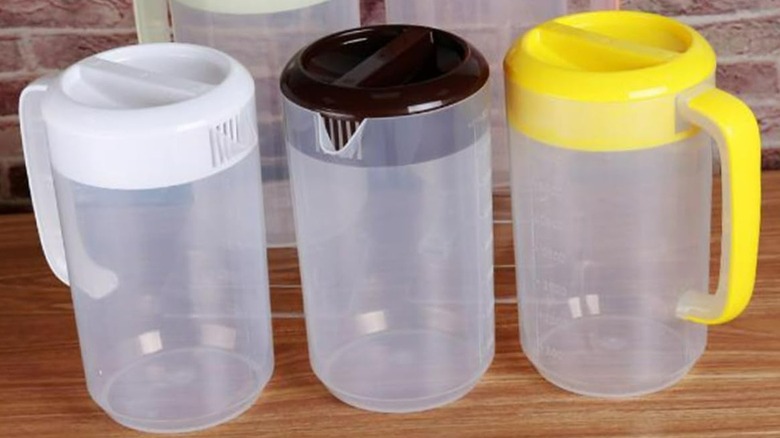Why You Should Add A Dollar Tree Pitcher To Your Garden For A Full Harvest
We may receive a commission on purchases made from links.
Using compost to fertilize your lawn or flowers is one of the best ways to not only feed your plants today but also build up the soil quality over the long term. But buying bags of the black-gold fertilizer from your local garden center adds up. With this gardening hack using plastic pitchers from Dollar Tree, you can start composting at home for just a few dollars. Simply drill some holes into the pitcher, bury it in your soil, and start adding compostable scraps to it.
Not only is this a genius hack for making your own DIY compost system for just a few dollars, but it's also a great way to start composting with limited space. If you have a small garden, you may not have room for a big compost heap or bin, but you can probably make some room for a pitcher or two buried directly into your garden beds or containers.
In addition to space-saving and cost-saving benefits, it's also convenient. The design of the lid is easy to remove without snapping or twisting, like other food containers you might have on hand. So it's easy to toss scraps in as needed while keeping them covered the rest of the time. Plus, the holes you added allow the water to pull fresh leachate, packed with nutrients and beneficial microbes, from the compost inside the pitcher into the soil surrounding it. It's basically a low-effort alternative to brewing compost tea to feed your hungry plants.
Compost in place with Dollar Tree pitchers
This gardening hack is as easy as it is cheap. To start, drill holes all over the pitcher, with the lid included. In her YouTube video, Robbie uses a soldering iron to melt holes through the plastic. If you don't have one, you can try a power drill. The goal is to perforate every surface so that water can drain out of your pitcher instead of pooling inside. After you've added holes, bury your pitchers throughout your garden. As seen in the video, Robbie buries them about halfway into the soil and helps to help jumpstart the composting process by scooping about a handful of garden soil into the pitcher.
Once the pitchers are in place, you can start adding anything you would typically add to your compost. That includes most kitchen scraps as well as yard waste like grass clippings and leaves. To speed up the process, shred or chop scraps into smaller pieces so they can break down faster. If a pitcher fills up, you can remove any finished compost and mix it into your soil.
The only ongoing maintenance required is the occasional watering to keep the organic matter inside moist. Since the pitchers are already buried in your garden beds, you can simply water them whenever you water your plants. As that organic matter starts breaking down, it'll become a nutrient-rich compost slowly seeping out of the drainage holes in the form of compost tea that your plants will love.
